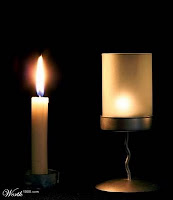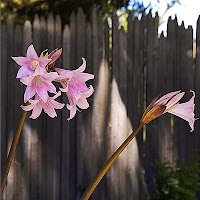
Book Review: The Book of Common Prayer, "My carry-with-me copy is this size, and I recommend it for traveling places..."
by Peter Menkin
Here I am daring to comment on this wonderful book, used by Episcopalians and one of the prayer and rubric publications that unite Anglicans worldwide. (There are about 77 million Anglicans in the world, and most have their own "version" of this wonderful and inspired book, though perhaps this specific size of which I write and this specific American version, may not be familiar to them all.)
My copy that is this size, and at a similar good price as this one (take advantage of a good offer, by the way), has been used by me for about ten or so years. It's been a durable book, though worn now and the leather cover warped, despite my treating it from time to time. But then I carry it in my car, and sometimes leave it on the seat where the sun hits it. Nonetheless, it has proved durable.
There are so many personal uses for the prayer book, and touching on some of them, it is important for me to note in this recitation, that the primary purpose of this issue of The Book of Common Prayer for me is taking it to nursing, hospital, and similar places (including home visits), to administer home Communion. It is an excellent size for traveling, and as I may not have mentioned, also offers the complete book with all the prayers and this includes, "Communion under Special Circumstances," used in the Episcopal Church for bringing home communion.
As a licensed lay Minister in my Church, and as an Oblate, I am always moved and informed by the same words from that shared, intimate service. To give you reader, an idea of the character of the book, here is a quote from the beginning prayer of the section "Communion under Special Circumstances."
"Almighty Father, whose dear Son, on the night before he suffered, instituted the Sacrement of his Body and Blood: Mercifully grant that we may receive it thankfully in remembrance of Jesus Christ our Lord, who in these holy mysteries gives us a pledge of eternal life; and who lives and reigns for ever and ever. Amen."
There is flexibility in the prayers, and the rubrics allow the lay minister or clergy administering the Eucharist to do the following: "After the reading [found before the opening prayer quoted above], the Celebrant may comment on it briefly." Also, "Suitable prayers may be offered, concluding with the following or some other Collect."
My opinion is the book, both a religious, spiritually literary, and inspired work, encourages spiritual discussion of a religious nature after or before the words of the service. In this way, the Eucharist is a community or communion activity, where the idea of sharing the Church experience is enlarged in the presence of God and man.
When I visit the elderly, especially the frail elderly in my visits, I sometimes share Psalms. The book contains all 150 Psalms, its own translation, of course. This one is a favorite of mine, not only because of its familiarity, but as well because it is a kind of statement about the journey and ministry with which I am engaged in this pastoral relationship:
Psalm 23
The Lord is my shepherd
I shall not be in want.
He makes me lie down in green pastures
and leads me beside still waters.
He revives my soul
and guides me along right pathways for his Name's sake.
Though I walk through the valley of the shadow of death,
I shall fear no evil;
for you are with me;
your rod and your staff, they comfort me.
You spread a table before me in the presence of those who trouble me;
you have anointed my head with oil,
and my cup is running over.
Surely your goodness and mercy shall follow me all the days of my life,
and I will dwell in the house of the Lord for ever.
This is a good place to end the review.
(This review appeared originally on Amazon.com.)
Notes on review: A friend tells me via email the review is "Too long and too much about your personal ministry. You might try reading other reviews (if any) or looking at what Church Publishing says about it."
I am happy for the critique and suggestions. Here is my response, in part, "As you can tell from the review, my intent was not to take on the book itself for review, but a part of it relevant to me and specific to that particular 'version' (inexpensive, small, portable, and useful for a specific purpose and kind of ministry).
"I also wanted to speak to Episcopalians themselves, as well as Christians, mostly, in a way that would engage them in the review based on experience, rather than expertise. To do that, I thought I needed to use my own personal (though personable might be a better term), than expert opinion.
 "For me, dealing with so awesome and holy a work has more validity and genuineness by the stance used. Certainly, there is a kind of authority in this kind of review by testimony (granted that is an important focus of the review, by intention).
"For me, dealing with so awesome and holy a work has more validity and genuineness by the stance used. Certainly, there is a kind of authority in this kind of review by testimony (granted that is an important focus of the review, by intention)."There you have an explanation of why I wrote it as I did, and part of the rationale for the conception of the approach."
I add as of the posting of the review here: I do hope readers will find the review both interesting and able to inform them of some merits of the holy prayer book for Episcopalians in America, The Book of Common Prayer.
It is many things, and contains instructions for worship services including Eucharist, Daily Prayer, Burial, and other rites and sacraments of the Church. As a literary work, it is a marvel and famous as well as admired in that regard. I cannot say how much I have found in this book, and others have found, too.
It does bring one closer to God in Christ and reveals a central part of worship for Episcopalians. An indispensable book for so many Christians of that denomination, and good reading for others who may be interested.
I hope my added notes help the review satisfy some of my friend's objections.
Photo notes: "Exotic Bali 10" is a photograph by amateur photographer Terry Peck. Terry lives North of San Francisco, California USA.















